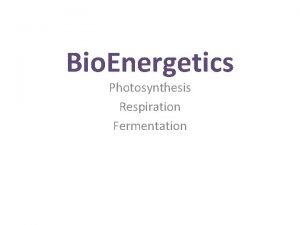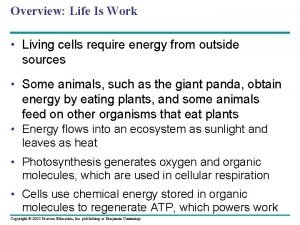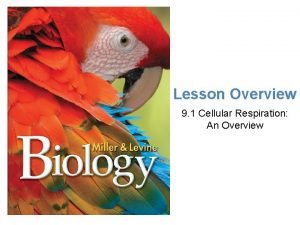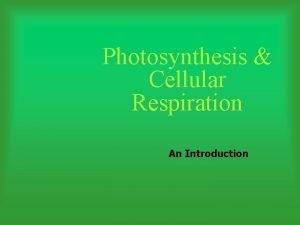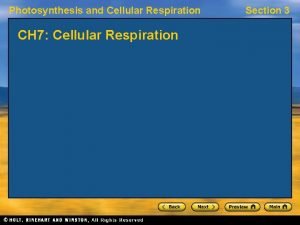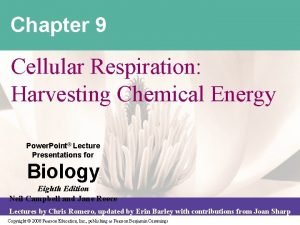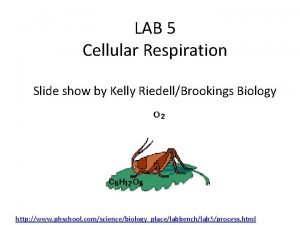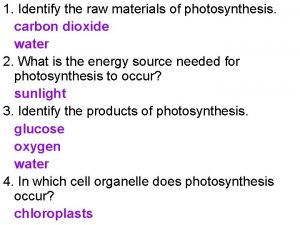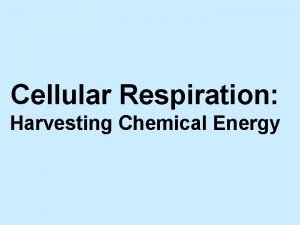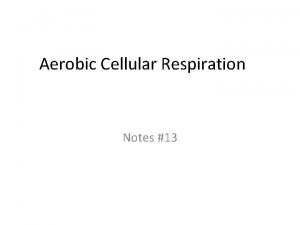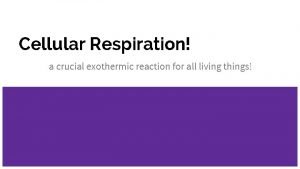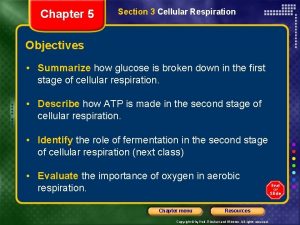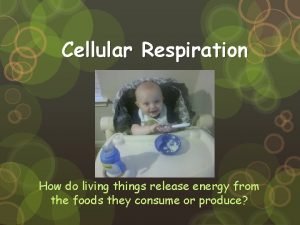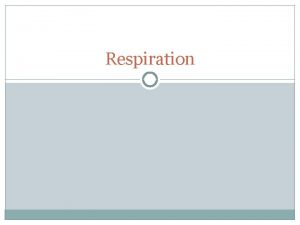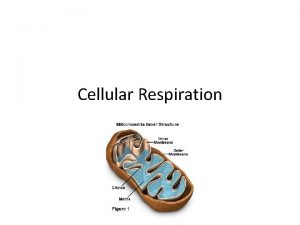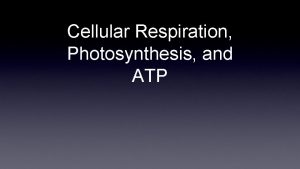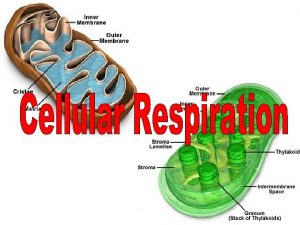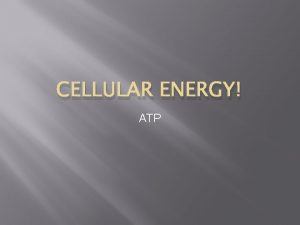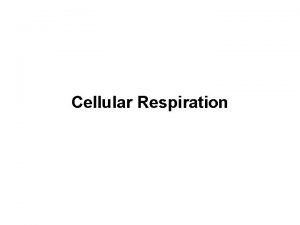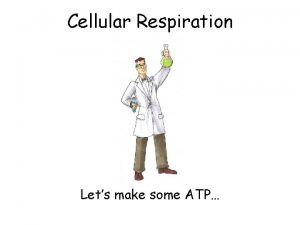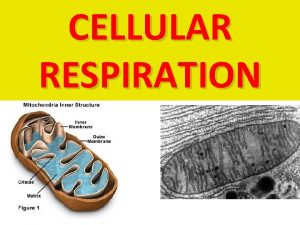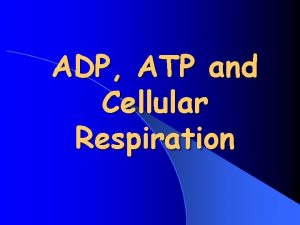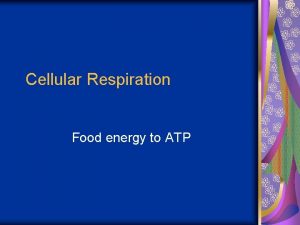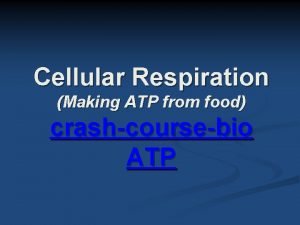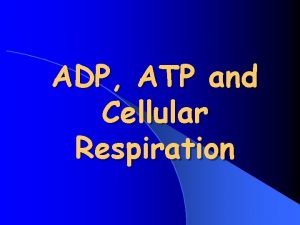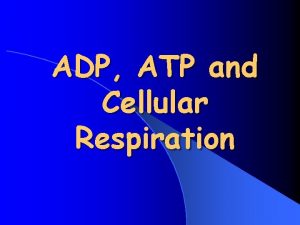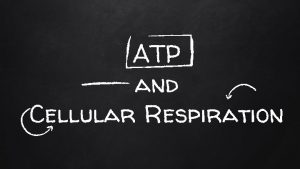Cellular Respiration ATP Cellular respiration overview 3 50























- Slides: 23

Cellular Respiration ATP

Cellular respiration overview (3: 50) http: //www. youtube. com/watch? v=n. GRDa_YXXQA&feature=fvwrel Cell Respiration Preview (6: 40) http: //www. greatpacificmedia. com/#glycolysis_dvd

Chemical Energy and Food • A lot of energy in food- one gram of glucose has 3811 calories • A calorie is the amount of energy it takes to raise 1 gram of water 1 degree Celsius • A food calorie (also called a Kilocaloriekcal) is equal to 1000 “chemistry” calories

Chemical Energy and food cont… • Cells do not burn glucose- they gradually release energy from glucose (food). • The process of breaking down glucose is called cellular respiration.

Cellular Respiration • 6 O 2 +C 6 H 12 O 6 6 CO 2 + 6 H 2 O + energy • Look familiar? It’s photosynthesis but backwards! • Cellular Respiration. Breaking down food in the presence of OXYGEN.

Cellular Respiration cont • Cellular respiration is made of 3 parts: 1. Begins with glycolysis (takes place in the cytoplasm) 2. Krebs Cycle (mitochondria) 3. Electron Transport Chain (mitochondria)

Cellular Respiration Summary

Glycolysis • Glycolysis is the process in which one molecule of glucose (6 carbons) is broken in half producing two molecules of pyruvic acid (3 carbons each) • Occurs in cytoplasm of cell • Even though glycolysis is part of an energy releasing process, it takes some energy to get it started. – 2 ATP used, 4 ATP produced = 2 net ATP produced – NADH produced (high energy electron carrier) Glucose 2 Pyruvic acid To the electron transport chain

Krebs Cycle • After Glycolysis, if there is oxygen present then another path is taken, one that is aerobic Glucose Glycolysis Krebs cycle Fermentation (without oxygen) Electron transport Alcohol or lactic acid

Krebs Cycle cont… • The second stage of cellular respiration is the Krebs Cycle • During the Krebs cycle, Pyruvic acid is broken down into carbon dioxide Pyruvic acid CO 2 • Also known as the “citric acid cycle”

The Krebs Cycle cont… Section 9 -2 Citric Acid Production Mitochondrion Besides CO 2, what else is produced? • 1 ATP produced: used for cellular activities • NADH/FADH 2 (high energy electron carriers) produced: go to electron transport chain

Electron Transport Chain • The electron transport chain uses electrons from the Krebs cycle to convert ADP ATP

Section 9 -2 Electron Transport Chain Electron Transport Hydrogen Ion Movement Channel Intermembrane Space Mitochondrion ATP synthase Inner Membrane Matrix ATP Production • H+ concentration gradient is built up • H+ ions diffuse through ATP synthase protein • As ATP synthase spins, it creates ATP • At the end of the chain, electron is combined with H and O to produce water (H 2 O)


Energy and Exercise • In order for a human body to move it needs ATP for energy • In the beginning of exercise, the body uses stored ATP in cells (but only for a few seconds of energy) • Then the body relies on ATP made from lactic acid (for about 60 -90 seconds)

Energy and Exercise cont… • For long term, the body needs to use cellular respiration as source of ATP • This supply of ATP is continuous but not instantaneous • Body has enough stores of glycogen (sugars) to supply cellular respiration for 15 -20 minutes – After 15 -20 minutes, must break down other molecules, fats, to use for energy

A video demonstrating the importance of oxygen in exercise… • http: //video. yandex. ru/users/jlipeiton/vie w/175/

Chemical Pathways Glucose Glycolysis Krebs cycle Fermentation (without oxygen) Electron transport Alcohol or lactic acid

Fermentation • When oxygen is not present, glycolysis is followed by fermentation • Fermentation is anaerobic (doesn’t need oxygen) • There are two types: – Alcoholic fermentation – Lactic acid fermentation

Fermentation cont. . •

Alcoholic Fermentation • Used by yeast and other micro organisms forming alcohol and CO 2 as wastes Pyruvic acids + NADH alcohol + CO 2 + NAD+

Lactic Acid Fermentation • Lactic Acid forms in muscles when the body cannot supply enough oxygen to its tissues • When you exercise very quickly your muscles run out of oxygen, and your body begins to produce ATP by lactic acid production

Energy Movie- click to play
 Overview of cellular respiration
Overview of cellular respiration Cellular respiration and photosynthesis equation
Cellular respiration and photosynthesis equation Atp formula cellular respiration
Atp formula cellular respiration Total atp produced in cellular respiration
Total atp produced in cellular respiration Cellular respiration
Cellular respiration Overview of cellular respiration
Overview of cellular respiration Overview of cellular respiration
Overview of cellular respiration The stages of cellular respiration
The stages of cellular respiration Photosynthesis and cellular respiration
Photosynthesis and cellular respiration Section 3 cellular respiration continued
Section 3 cellular respiration continued Chapter 8 section 3 cellular respiration
Chapter 8 section 3 cellular respiration Inputs of glycolysis
Inputs of glycolysis What is the opposite of photosynthesis
What is the opposite of photosynthesis Lab bench cellular respiration
Lab bench cellular respiration Raw materials for photosynthesis
Raw materials for photosynthesis Cellular respiration equation
Cellular respiration equation Cellular respiration
Cellular respiration Output of electron transport chain
Output of electron transport chain Aerobic cellular respiration
Aerobic cellular respiration Cellular respiration endothermic or exothermic
Cellular respiration endothermic or exothermic Section 3 cellular respiration worksheet answers
Section 3 cellular respiration worksheet answers Cellular respiration releases
Cellular respiration releases Cellular respiration product
Cellular respiration product Explain how amp stimulates cellular respiration
Explain how amp stimulates cellular respiration


